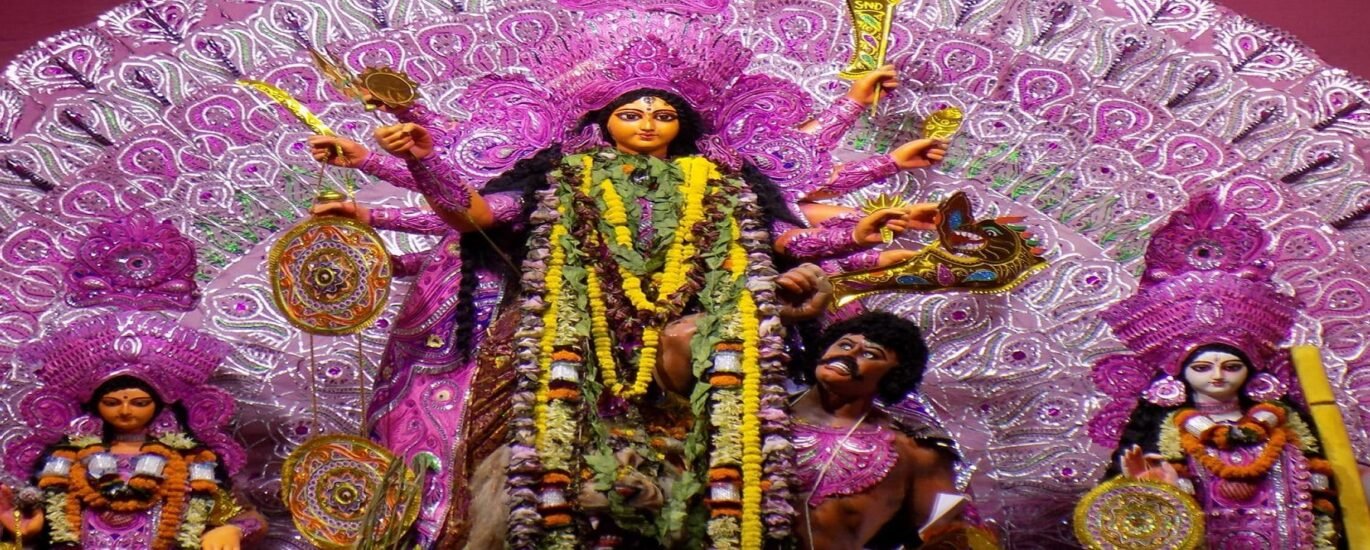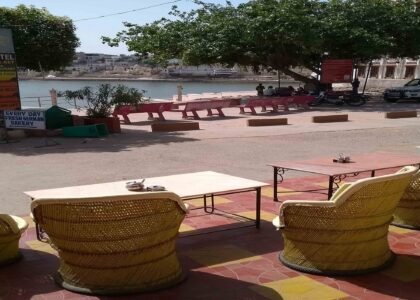This nine-day festival begins with Mahalaya and culminates with Vijayadashami or Dussehra, during which Durga Puja are immersed into rivers during Navami (the final day). Meanwhile, sculpture-idols are displayed in magnificent pandals that often receive sponsorship from well-known brands.
Married women offer Goddess Durga red vermillion powder (Sindoor) as an offering and use it to adorn themselves as this symbolizes marriage, fertility and childbearing.
West Bengal: The Epicenter of Festivity
Durga Puja is an annual festival honoring Goddess Durga and her victory over Mahishasura, the buffalo-demon. Over its 10-day run, idols of Durga are worshiped in magnificent pandals for 10 days of this festival, starting on Mahalaya and lasting until Vijay Dashami when Durga returned home with Shiva; during that period Lakshmi, Saraswati, Ganesha and Kartikeya deities are also venerated since they are believed to be her offspring.
On Saptami, a traditional Hindu ritual called Pran Pratisthan takes place, whereby an idol is bathed with water and decorated with flowers and clothes. On Ashtami, devotees celebrate through dance while covering one another in sindur – red cosmetic powder used as makeup.
Durga Puja celebrations attract large crowds dressed in traditional Indian clothing such as saris or traditional attire, including elaborate food preparation known as bhog for devotees. At community and neighbourhood levels, Durga Puja has evolved beyond being simply religious observance and is more like an art carnival with different themes being explored and elaborate food preparation for devotees known as bhog. Book India Tour Packages
Odisha: Where Traditions and History Interweave
Durga Puja is celebrated across Assam, Tripura, and Odisha; however it remains less well known here. Bhubaneswar in particular boasts some truly amazing Durga idols that can reach 20 feet tall with beautiful silver and gold filigree work covering them.
According to the Markandeya Purana, King Suratha of Chedi dynasty began celebrating this festival in 300BCE at Kalinga (modern Odisha). Since then many Shakti Peethas (temples dedicated to Goddess Durga in different forms) have taken place throughout Kalinga with animal sacrifice being banned decades ago due to social protest.
Odisha boasts a vibrant culture rich in ethnic, folk and craft traditions. Bhubaneswar, its capital city is home to Kalabhoomi Museum which showcases various aspects of Odisha craftsmen’s skills such as Terracotta painting, Traditional paintings on wood and stone crafts as well as handloom production – this museum also includes courtyards depicting tribal living environments as well as temple architecture which offer visitors a wonderful glimpse into Odisha’s vibrant past! It makes an excellent visit.
Assam: A Blend of Devotion and Folk Traditions
Assamese families commemorate Durga Puja with traditional folk music and dance, featuring master artisans demonstrating cane and bamboo work, bell metal smithy, silk weaving, cotton weaving, pottery making, terracotta art as well as pottery-making skills – each intertwined with cultural and spiritual practices of Assam.
Durga Puja, also known as Durga Jayanti, honors not only Durga but her children too – Lakshmi (the goddess of wealth), Saraswati (the goddess of music and knowledge), Ganesha (the god of new beginnings) and Kartikeya (the war god). This day is celebrated fervently at Kamakhya Temple of Guwahati.
Assam’s tea tribe communities celebrate Karam Puja – an annual festival designed to appease Mother Earth in order to secure bumper crops and avoid evil forces – in order to increase bumper harvests, protect from harm, and give thanks. At this time they also present their first grains as offerings to Mother Earth while accompanying this festival with drumming and pepa playing! The entire celebration includes music played on traditional instruments called dhols and pepa.
Tripura: A Confluence of Cultures
Tripura is an intricate melting pot of cultures. Most of its population are tribal peoples speaking languages such as Bengali (Bangla), Kokborok (Tripuri) and Halam (a subgroup of Kuki). At Durga Puja, these indigenous communities participate in age-old rituals alongside mainstream Indian traditions; one immersive experience includes throwing earthen pots filled with burning coconut husks and camphor around a Durga idol while drummers perform an intriguing rhythmical rhythm called Dhunuchi Dance which involves throwing earthen pots filled with burning coconut husks and camphor around a Durga idol while drummers provide a steady beat of sound!
At Mahalaya, other Hindu deities such as Lakshmi, Saraswati, Ganesha and Kartikeya are honored. Celebrations start on Mahalaya when Goddess Durga is invited down from heaven with an auspicious ritual called Chokkhu Daan; eyes of statues are painted red to signify her descent onto earth.
Magnificent pandals resembling the architecture of iconic landmarks are set up, while locals adorn idols with flowers, clothes and jewellery to celebrate this festival. There are street food stalls selling everything from Golgappas to bajjis nearby; on the final day a special ceremony called Pran Pratisthan invokes Goddess’ holy presence into idols through Kola Bou – a small banana plant which is given water baths while wearing a sari to represent Her energy transporting energy from idols back into idols through small banana plants named Kola Bou – an animal used by priest semen during Pran Pratisthan ritual performed to invoke Her holy presence into idols of this festival.
Bihar/Jharkhand: Simplicity and Social Harmony
Durga Puja (or Durgotsava) commemorates Durga’s triumphant win against Mahishasura and lasts from Sasthi to Vijayadashami each year, during which time statues of Durga are worshiped in pandals around town; neighborhoods compete to build the best one based on a chosen theme; once completed they are then transported through procession to local rivers where their images will be immersed at night, symbolizing her return home in Himalayas. Durga Puja forms part of Navaratri festival that runs across India every nine nights; worship also includes Lakshmi Sarasvati and Ganesha along with worship of Lakshmi Sarasvati and Ganesha
As part of their social activities, many activities take place during this time, such as bhajans, dance performances and dramas. Temples, stages and pandals decorated beautifully draw large crowds each day; on the final day, married women mark this as an act of gratitude to and an offering to the goddess by applying vermilion powder (Sindoor Khela) on their foreheads as a mark of appreciation and as part of an offering made to her; it also marks her leaving after spending 10 days here!
Delhi: A Melting Pot of Celebrations
Durga Puja may be associated with Bengal, but its celebration has spread all across India and reflects different cultural traditions. Families gather and exchange gifts while enjoying traditional delicacies.
Worshippers pay their devotion to Goddess Durga by visiting massive pandals that house her statues during this festival season. Each structure is decorated according to specific themes, while neighborhoods compete to build the most elaborate ones. Furthermore, it helps boost income of professions such as Kumors (those who create idols) and Dhaakis (dancers).
On Mahalaya, the opening day of puja, Goddess Durga is believed to have made her entrance. To welcome her she is met by artists practicing Chokkhu Daan; once in place her eyes will be painted onto statues by artists. Later comes Pran Praptithan which involves invoking various gods and goddesses to breathe life into their statues.
Vijaya Dashami marks the conclusion of this festival and sees images of Durga being transported in grand processions to rivers for immersion – this symbolizes her return to Lord Shiva in Himalayan mountains where their marriage took place.
Maharashtra: The Power of the Feminine
Maharashtra brings its own distinct twist to the festival. While West Bengal tends to focus more on extravagant celebrations, here pandals are decorated with simple themes and idols are carefully sculpted. Many puja committees host cultural programs featuring professional artists throughout the duration of the celebrations.
Mahalaya marks the arrival of Goddess Durga to her home and on Navami is worshipped as Kumari (virgin girl). Married women offer red color powder (Sindoor) as offerings to her and wish for her health and fertility in their husbands.
Vijayadashmi marks the final day, when images of Goddess Durga riding her lion against demon Mahishasura are carried in large processions to local rivers and submerged. This symbolizes her return to her husband Shiva in Himalayas. Also worshipped during this festival are Goddess Lakshmi and Saraswati images; during Tamil Nadu celebrations this festival with Golu- a tradition where young local girls display wooden dolls.
Gujarat: The Circle of Unity
Durga Puja marks the triumphant triumph of Goddess Durga over Mahishasura, and is celebrated nationwide during September-October. Festivities center around worshipping Durga as she represents divine feminine power while creating opportunities for family bonding and feasts.
People from all walks of life assemble at public spaces known as pandals during this season to worship and seek blessings from the goddess. These pandals are decorated beautifully, featuring scripture recitations, chants and mantras; lights; cultural performances and parades; plus large meals known as bhog that usually include rice, sweet dish and fried item with chutney.
On top of praying, devotees also visit and appreciate magnificent pandals set up across cities with themes selected each year by local authorities. On Dusshera or Vijaya Dashami day – known for burning effigies of demons – locals celebrate by feeding young girls either with money or gifts as part of this festival.






